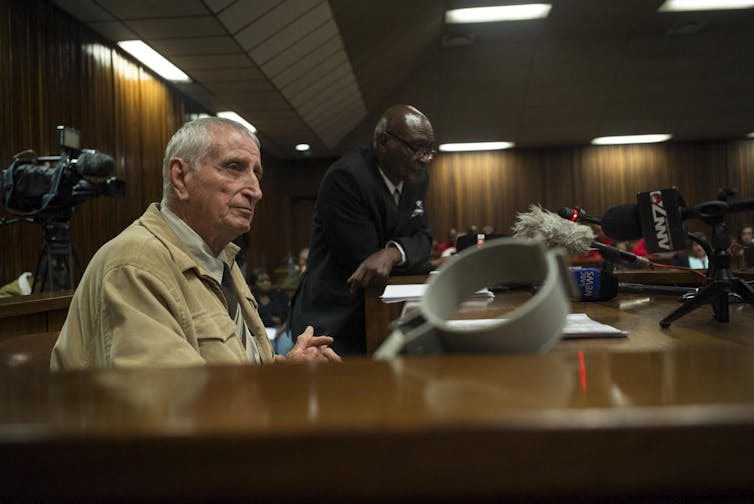
Former policeman Joao Rodrigues giving evidence at the Timol Inquest.
Anthony Schultz/Mail & Guardian
The recent, reopened inquest into the death of teacher and anti-apartheid activist, Ahmed Timol, was different in many ways from a traditional court case. Instead of the standard adversarial criminal trial, which is associated with an acrimonious standoff between opposing parties, the state and the representative of the Timol family, Advocate Howard Varney, seemed to agree on the importance of arriving at the truth about Timol’s death.
Timol was 29 when he was arrested on 22 October 1971. After being interrogated and tortured by the feared security branch of the police, he died on 27 October 1971. Magistrate JL de Villiers, who presided over the inquest that followed his death, found that Timol had committed suicide.
The reopened inquest in the North Gauteng High Court nearly 50 years later was intensely symbolic. The atmosphere in the court was heavy with history. At times the testimony of witnesses reminded one of funeral-like memorialisation. It was clear that the case was not only about Timol’s death but about the dozens of victims who died at John Vorster Square, the notorious Johannesburg security branch headquarters, and more broadly, the countless victims of apartheid crimes.
Throughout the hearings Judge Billy Mothle heard compelling testimony from witnesses such as Timol’s friend and fellow detainee Salim Essop. Essop testified of brutal torture including electric shock treatments and attempts to suffocate detainees.
In concluding his deliberations after hearing the evidence, Judge Billy Mothle found that Timol was either pushed from the 10th floor of John Vorster Square or from the rooftop of the building.
The ruling has been seen as a vindication of the tireless efforts on the part of Timol’s family and friends to have the apartheid security force’s lies and misrepresentation of the young activist’s final days overturned.
Truth and reconciliation
The Timol case resurrects many of the questions South Africa raised during the Truth and Reconciliation Commission (TRC), and in its direct aftermath. In many ways, the Timol case can be understood as a continuation of the work of the commission: the reopening of an inquest can be a way of establishing the truth of apartheid era atrocities.
In some ways, court proceedings are more efficient and powerful than hearings of the TRC kind. Courts have the power to subpoena witnesses and to declare lying witnesses in contempt of court. In addition, their judgments form formal precedent for future decisions. Court cases are also infused with a certain weight and formal authority.
One of the most serious criticisms of the design of the TRC was that it had the power to grant amnesty under certain conditions. While the conditional amnesty model was lauded as innovative and reconciliation-building, over two decades later it’s clear that there were crucial gaps in the amnesty scheme.
Firstly, the truth uncovered by the amnesty hearings was a selective truth in the sense that many apartheid victims didn’t have the means to travel to the sites of the hearing to testify. Secondly, many former perpetrators didn’t apply for amnesty. Many must have made a calculated guess that they were unlikely to be prosecuted if they did not apply for amnesty.
And there have been less than a handful of prosecutions post TRC. This arguably makes a mockery of the amnesty scheme. Also, the National Prosecuting Authority’s Priority Crimes Litigation Unit has been exceedingly passive. It’s this unit that failed to follow up on important cases such as the Wouter Basson case. Dubbed “Dr Death” in the media, Basson was the head of the apartheid government’s chemical and biological warfare programme. When the Constitutional Court gave the prosecuting authority the go ahead to prosecute, it failed to follow up.
In light of the poor, lacklustre track record of the state over the past 20 years, there’s little reason for optimism that all apartheid era inquests will be reopened. There can be no doubt that reopening inquests is an important way of discovering the truth about the past and setting the historical record straight.
Many cases will be obstructed by the fact that witnesses and accused would have died in the decades since the killings.
Even if witnesses are alive their memories often fail them as might have been the case with Joao “Jan” Rodrigues in the Timol inquest.
Banality of evil
Rodrigues was one of the policemen present at the time of Timol’s killing and is accused of helping to hide the evidence of his killing.
When testifying at the Timol hearings, Rodrigues (78) was completely uncooperative and continuously claimed that he could not remember the events of October 1971. Watching from the public gallery, I found Rodrigues the most interesting of the witnesses. He was interesting precisely because he was ordinary and reminded me of philosopher Hannah Arendt’s concept of the “banality of evil” in “Eichmann in Jerusalem: A Report on the Banality of Evil” – her account of Nazi officer, Adolf Eichmann, who Arendt thought willingly did his part to organise the Holocaust but in a non-ideological combination of careerism and obedience.
Rodrigues’s testimony is representative of the denial of a whole generation of white South Africans. He did not show a slither of remorse. His body language conveyed a certain irritation and annoyance at the fact that he was hauled from the daze of retirement into the spotlight of a prominent and inconvenient court appearance. He conveyed that he was somehow being victimised by a process he found strange and unnecessary.
Appropriate relief
Judge Mothle stated that the perpetrators are dead. This raises the question of appropriate relief – a question which is still unclear. But punishment of perpetrators is not the primary relief sought by victims of state sponsored atrocities.
Mia Swart, Professor of International Law, University of Johannesburg
This article was originally published on The Conversation.
No comments:
Post a Comment